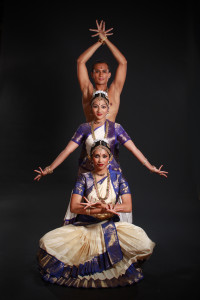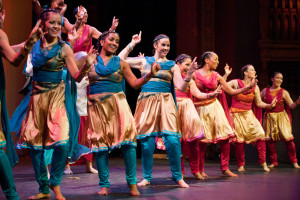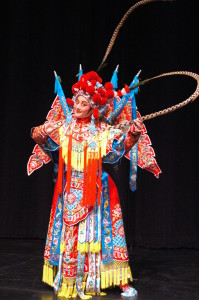If you’re reading In Dance, then I probably don’t need to tell you that among San Francisco arts organizations, CounterPULSE has one of the strongest reputations for presenting risk-taking and innovative contemporary work. I also probably don’t need to tell you that the Bay Area is exploding with artists who are working in diverse culturally-specific and traditional art forms. Performing Diaspora, which returns to CounterPULSE this August with a festival of new work, is the place where this growing regional trend intersects with this ground-breaking presenter.

Photo by Frank Marino
It is important to be clear that Performing Diaspora is not for artists who want to cherry-pick cultural cues to incorporate into a post-modern novelty as ornaments. Instead, the program is for artists based in a culturally-specific form or a tradition, who are developing new work that is experimental and innovative, but still grounded within their genre or tradition.
As Indian dance artist Nadhi Thekkek told me, the work she is creating for the program “is not trying to deconstruct the form—the form is my voice and I love it.” Instead, Thekkek and the five other artists in the Performing Diaspora cohort are reconnecting with, and ultimately expanding their traditions. It’s a more subtle and challenging goal for an artist, and one that requires no small degree of courage.
As CounterPULSE’s Executive and Artistic Director Jessica Robinson Love describes it, Performing Diaspora came into existence as, “an organic response to what was already happening at CounterPULSE…we had a tremendous number of traditional artists who were already coming in and applying for the programs we already had that were about developing new work.”
The program was conceived in 2007 over dinner with artist and former Alliance for California Traditional Arts Associate Director Sherwood Chen. While discussing the growth of traditional artists entering CounterPULSE’s sphere they discussed what support opportunities existed for traditional artists. There were presentation opportunities like the San Francisco Ethnic Dance Festival, which didn’t offer in-depth residencies to support the development of new work. Other organizations did provide that kind of deep support, but weren’t presenting artists from a traditional background as part of their contemporary presentation series. It was in this gap between these opportunities that the idea that became Performing Diaspora was first envisioned.
“It was literally one of those back of the napkin ideas,” Love tells me, but the idea quickly flourished into an ambitious state-wide program.
The first cycle of Performing Diaspora took place in 2009 and 2010. Love and the first group of curators (Chen, Laura Elaine Ellis and Debbie Smith) spent a great deal of time finding the right structure for the program. Eventually they settled on a residency/work-in-progress and feedback/festival presentation model that was based on CounterPULSE’s artist-in-residency program and the organization’s particular blend of structured support plus creative freedom.

Photo by Vijay Rakhra
As Love describes it to me, Performing Diaspora differs from the artist-in-residency program in that there is benefit in having a cohort of artists who are tackling similar issues, questions and ideas: “Many of these artists don’t come from a western European background, many of them are struggling with similar issues around their teachers and their lineage— how they hew to that lineage and what a departure from that means for them.”
The program also includes a day-long symposium that explores some of the issues raised by the artists’ work. “We have this critical mass of energy around Performing Diaspora,” Love explains, “and we think those conversations support the performances, and that those artists who are performing are going to be enriched by participating in the symposium.”
Performing Diaspora was ambitious in its first round. It was a statewide program that had 13 artists in the first year, with five of those artists presenting full length works in the second year. As with any program in its early stages, lessons were learned about the difficulty of working across the entire state, and about differences in the culture of performing between Los Angeles and San Francisco.
Despite the challenge, some amazing work was produced in the previous Performing Diaspora cycle, most memorably (for me) Aida Whitaker’s multidisciplinary work Ampey! Additionally, Love points out that more organizations have populated their programming with performances that explore the intersection between traditional arts and contemporary presentation in ways that weren’t happening before the program began.
The 2013 Performing Diaspora cohort is smaller (6 compared to 13) and is entirely Bay Area-based, but they are presenting some exhilarating work for the stage this August. One of the artists working on a powerful and challenging new work is Byb Chanel Bibene, a Congolese artist whose multi-disciplinary piece, Taboo and Heroes addresses his personal experiences as a survivor of civil war in the Republic of Congo. He’s using dance, music, theater and video in a single work that will also explore the importance of creating connections across communities.
Three of the artists are creating works that explore the lives of historical figures and movements within their own culture. Joti Singh will debut Red, Saffron and Green, which will use dance, music and text to explore the Gadar Party, a political party formed by Punjabi activists in San Francisco in the early 20th century that advocated for Indian independence from the British Empire. Singh’s great-grandfather was president of the party from 1914-1920.
In The Ginzburg Geography, composer Jewlia Eisenberg explores the lives of Natalia and Leone Ginzburg, Italian Jews who were active in anti-fascist politics in in 1930s Italy. Eisenberg and her vocal ensemble Charming Hostess will perform new music drawn from traditional Italian Jewish music, and from the personal and political writings of the Ginzburgs.
Muisi-kongo Malonga’s Kimpa Vita! will use traditional Congolese forms and African American culture and music to tell the life of Kimpa Vita, a 17th century spiritual leader in the Kingdom of Kongo. Malonga’s solo piece will be a chore-opera, combining dance and music to tell the story of this woman who has been described as a Kongolese Joan of Arc.
Two of the artists are creating new work based around their personal response to works of literature. The Cloud Messenger by Nava Dance Theater is drawn from a poem by the 5th century Sanskrit poet Kalidasa. This company of three dancers will use the highly expressive Indian classical form of Bharatanatyam in story of a message of love being sent from one lover to another through a rain cloud.
Finally, Jia Wu’s Mama/Medea places the classical Greek figure from Euripides’ tragedy within the context of Chinese classical dance to explore Wu’s own personal experience as a Chinese immigrant, working artist and mother.
To someone not deeply embedded in a traditional art form, it may not be obvious at first glance how these works are innovative. Keep in mind that in many traditional forms it is the tradition—the convention, the liturgy, the ritual, the communal body of myth—that is what takes priority. Your success as an artist is in how successfully your work embodies the tradition and carries the message of the culture. This way of thinking about the form is usually entrenched in one’s training, and making the decision to explore personal dimensions using traditional forms is daunting if you want to stay true to the form. To do so is a delicate act of artistic courage.
For example, Nava Dance Company’s Nadhi Thekkek told me that her company’s version of The Cloud Messenger does not focus on Hindu religious deities, although the poem does, and the tradition is to center the story on deities. “My experience is totally different than the intended audience at the time,” she tells me, but in this piece it is personal interest that dictates the parameters of the work: “I’m allowing my emotions to dictate the development of the work rather than convention.”

Photo courtesy of artist
In the interest of moving the conversation about contemporary and innovative traditional work forward, the Performing Diaspora symposium will take place on August 10th. Designed by this year’s three curators—Roko Kawai, Lily Kharrazi and Umi Vaughan—it will feature four panels. The symposium will be valuable for someone who wants an introduction to issues raised by the artists in Performing Diaspora, as well as issues that are significant to the culturally-specific and traditional dance communities nationally. Some of the panel topics will include artistic response to war and violence, representation in Bay Area African dance, and expressing the sacred through performance. To borrow from Emma Goldman, I don’t want to go to a symposium if there’s no dancing, so fortunately Joti Singh will also lead participants in an experiential lecture/demonstration on Bhangra.
As of this writing, there has been one work-in-progress showing, and there will have been another by the time this article is published. For the artists, these showings, and the structured feedback sessions that accompany them is one of the essential components of the program. Having a smaller group of artists allows CounterPULSE and Love to spend more time developing a constructive supportive atmosphere for the artists. She explains: “We really made it clear to the artists that this was about process, and about building community and we got artists who were really committed and then did a lot of coaching and one-one-one work to make sure they understood what we’re offering.”
For Nadhi Thekkek, this was a new experience: “in the past feedback has been more like ‘this is what you should do with your work.’ In Performing Diaspora, every step has been my helping as an artist get to where I want to go.”
Musi-kongo Malonga agrees, saying that it was “a really powerful and inspiring experience to see how my unfinished, raw work was received….I left feeling empowered and informed about the other artists and their process.”
“Performing Diaspora is doing a really good thing by providing these opportunities,” she continues, “Very rarely do we have opportunities to have these dialogues with each other.”
The rarity of this kind of experience for traditional artists is shocking to Love: “It’s something that white, post-modern dancers take for granted…. Having people come and give them constructive feedback, and support them in their process—that’s just normal.”
In describing the support the artists displayed for each other during that first work-in-progress showing, Love was visibly moved. She explains that “that is what this program is for. Part of it is for the audience—we hope people see the shows in August and are super-excited about the performances and learn from them. But a huge component of it is for the artists and giving them support, and opportunities, and connections they wouldn’t have had otherwise.”
More information about Performing Diaspora performances, including artist blogs, can be found at counterpulse.org.
This article appeared in the July/August 2013 issue of In Dance.

